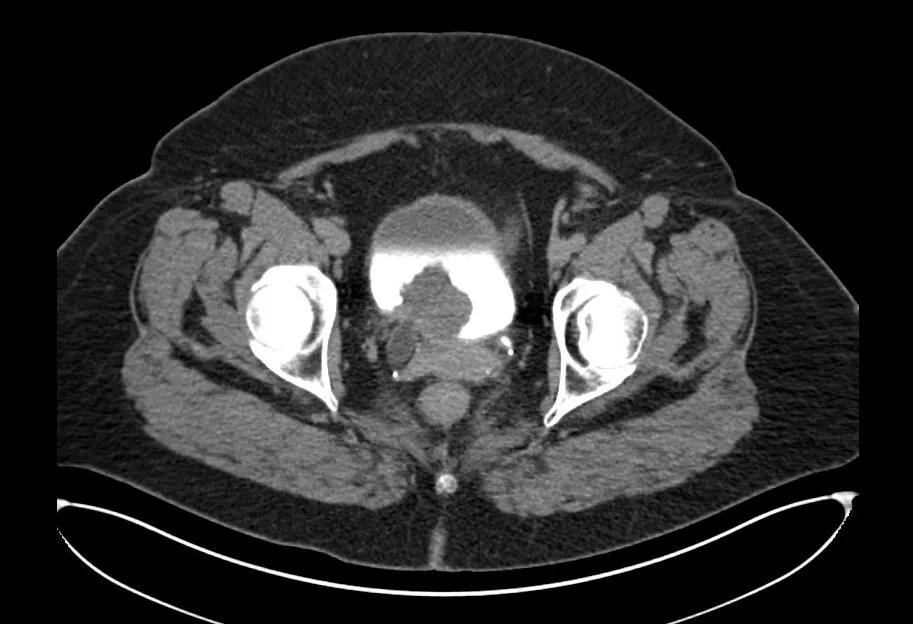Retrospective study evaluates clinical upstaging during neoadjuvant treatment

In muscle-invasive bladder cancer, interim imaging during neoadjuvant chemotherapy may help identify those who are not likely to respond to treatment, preserving their candidacy for a vaginal-sparing approach. So conclude the authors of a retrospective study, published in Urology.
Advertisement
Cleveland Clinic is a non-profit academic medical center. Advertising on our site helps support our mission. We do not endorse non-Cleveland Clinic products or services. Policy
The study found that, though rare, about 5% of female patients with trigonal muscle-invasive bladder cancer, were deemed ineligible for a vaginal-sparing cystectomy following standard-of-care neoadjuvant chemotherapy. Cleveland Clinic urologic oncologist Nima Almassi, MD, senior author of the study, says their hope was to understand how often upstaging occurred during this period as a means of earlier intervention for organ preservation.
The quality-of-life implications of cystectomy cannot be overlooked. In addition to the bladder, in women, the anterior vaginal wall, uterus, and ovaries are also often removed, which can increase the risk of sexual dysfunction and pelvic organ prolapse.
Improving survivorship in women with bladder cancer has become the focus of more recent investigations. New studies call into question the clinical utility of the removal of the vaginal wall, uterus and ovaries or promote awareness of other organ-sparing techniques.
At the time of diagnosis, staging is determined through imaging scans and transurethral resection of bladder tumor. Neoadjuvant chemotherapy followed by radical cystectomy is the traditional course of care.
However, not at all malignancies respond favorably to neoadjuvant therapy, explains Dr. Almassi, and sometimes disease will progress or worsen during this time.
The literature to date that has evaluated interim staging during chemotherapy has been focused on oncologic outcomes. However, the team couldn’t find any studies focused on imaging to optimize organ preservation.
Advertisement
Explains Dr. Almassi, “Restaging in the middle of chemotherapy may help identify nonresponders, so we can prioritize their surgery, and there are studies to support that. But the focus has been on oncologic outcomes for cancer-specific survival, not preserving eligibility for organ-sparing surgery.”
Using a Cleveland Clinic bladder cancer registry, the researchers identified 89 female patients with MIBC who were treated with neoadjuvant chemotherapy and radical cystectomy over a 10-year period (2012 to 2023). Of these, 75 patients received imaging before and after neoadjuvant chemotherapy.
Overall, six (8%) of the patients were clinically downstaged following neoadjuvant chemotherapy, while just two (5%) of patients with trigone tumors clinically progressed after neoadjuvant chemotherapy—both exhibiting vaginal invasion.
“The findings suggest that disease progression that would alter candidacy for a vaginal-sparing surgical approach is infrequent, but certainly can happen. Patients who harbor disease at the trigone, which is part of the bladder that's abutting or adjacent to the vagina, are at highest risk” he explains.
CT imaging has been considered the predominant modality for tumor staging, although MRI has become favored more recently for higher accuracy. The study largely reflects CT imaging data. Dr. Almassi says, though unclear, the use of MRI may yield a higher incidence of extravesical disease.
This represents not only a future direction for the research but also points to a shift in the diagnostic landscape of muscle-invasive bladder cancer as well as for surgical planning and functional outcomes of the disease.
Advertisement
Dr. Almassi says interim imaging should be a considered for select patients during the course of neoadjuvant chemotherapy.
“For patients who are initially eligible, motivated to have a vaginal-sparing surgical approach and who harbor cancer at the trigone, interim imaging could be a beneficial option,” he concludes.
Advertisement
Advertisement

Oncologic and functional outcomes are promising, but selection is key

Retrospective study finds acceptable cancer control among most histologic subtypes with intravesical therapy

What updated techniques, counseling and a changing workforce could mean

Reproductive urologists publish a contemporary review to guide practice

Two recent cases show favorable pain and cosmesis outcomes

Meta-analysis assesses outcomes in adolescent age vs. mid-adulthood

Proteinuria reduction remains the most important treatment target.

IgA nephropathy is a relatively common autoimmune glomerular disease that can be diagnosed only by biopsy